Whitland is an ancient market town, most well known for being the place where Hywell Dda sat in Parliament and created the first laws. The town is sited along the main A40 road from St Clears into Pembrokeshire, and is about six miles east of Narberth. In the front yard of the Congregational Chapel in West Street is a War Memorial in the form of a Celtic Cross, which holds the names of its members who fell during both World Wars.
To purchase a copy of my book on the Whitland War Memorial, please click HERE
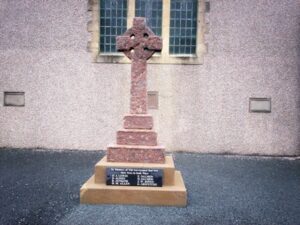
The Great War, 1914-1918
Harry Montague Allen, Private, 20965, Welsh Regiment. Harry was born in Prendergast, Haverfordwest, in 1896, the eldest son of Thomas and Edith Allen, and the family later resided at 3, Glendale Terrace, when Thomas moved with the GWR to work at Whitland. Harry followed his father into the Railway, becoming a Carpenter at the Llanelli Depot. At the outbreak of War, Harry was enlisted into the Army, entering the 15th Battalion, Welsh Regiment, known as the Carmarthen Pals Battalion. After training at Rhyl and Winchester, the battalion moved to France during December 1915 attached to 114 Brigade, 38th (Welsh) Division. During the coming months the Battalion held nearly every section of the British line from Givenchy on the La Bassée Canal to Laventie, about six miles South of Armentières. At the end of May 1916, the Battalion moved South with the remainder of the 38th (Welsh) Division to the Somme area, in readiness for the First Battle of The Somme, which commenced on 1 July 1916. The 38th Division were tasked with the taking of the infamous Mametz Wood, and the Division made its first assault on 7 July 1916, suffering terrible casualties. After the sacking of their Commander, Sir Ivor Philipps, the Division made a renewed assault on 10 July 1915, and the Carmarthen Pals were thrown into action, and plunged into terrible fighting at the ‘Hammerhead’. The wood was cleared with two days of terrible hand to hand fighting, but at the cost of over 5,000 casualties in the 38th (Welsh) Division. It was during the first attacks on the wood that Harry was shot in the chest by a German sniper, and brought back by rail to the 38th Casualty Clearing Station at Heilly, in the Somme valley. Harry died of his wounds on 11 July 1916, and was buried in Heilly Station Cemetery, France. He is also commemorated at Lampeter Velfrey and on the new GWR Memorial at Llanelli Goods Shed.
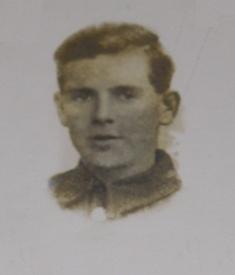
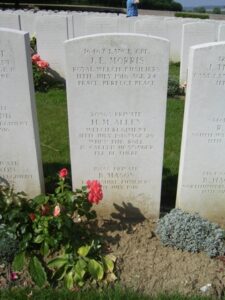
David James, Private, 35439, Gloucestershire Regiment. David was born at Beckenham, Kent in 1882, the son of George and Emma James. The family later moved to Whitland, where they named their new home in Market Street Beckenham House. David enlisted into the Army in Carmarthen, joining the Royal Engineers, with the service number 224035, but was later transferred into the 13th Battalion, Gloucestershire Regiment. The battalion served as the Pioneer Battalion in 39th Division. The Division moved to France at the end of February and early March 1916, and on 30 June 1916 it took part in a very costly attack in the area of Richebourg l’Avoue, which is not officially recognised as a separate engagement. The Sussex Battalions in particular suffered very heavy casualties. The Division moved to the Somme in August 1916, where it fought at the Battle of the Ancre Heights, where they captured the Schwaben Redoubt, and helped capture Regina Trench. They then fought at the Battle of the Ancre, and remained on the Somme over the winter. In 1917 the Division were at Ypres, and fought at the Battle of Pilckem, the Battle of Langemarck, the Battle of the Menin Road, the Battle of Polygon Wood and the Second Battle of Passchendaele. During the beginning of 1918 they were stationed near St. Quentin, and were one of the Divisions to be hit hard here by the German Offensive which was launched on 21 March 1918. They fought here at the Battle of St Quentin, and falling back fought at the Actions at the Somme Crossings and the Battle of Rosieres. They were moved to Flanders to rest, but April was to see the Germans launch an attack here at the Lys, and the Division fought at the First Battle of Kemmel. David was killed here on 26 April 1918. He was 36 years old, and is commemorated on the Tyne Cot Memorial, Belgium. He is also commemorated on the family grave at Zoar Chapel, Whitland.
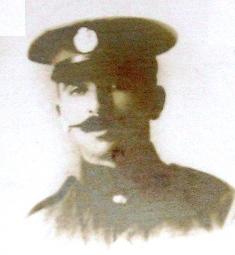
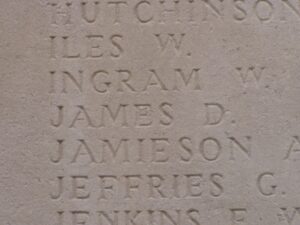
Richard Jenkins, Private, 201048, Welsh Regiment. Richard was born in Llawhaden in 1895, the son of William Jenkins and Elizabeth Jenkins (nee Adams). His mother died in 1909 and Richard went to live and work at Whitland. He enlisted at Llanelli soon after the outbreak of war, into the 1/4th Battalion, Welsh Regiment. The battalion was the local Territorial unit and mobilised for war at Carmarthen in August 1914, as part of South Wales Brigade, Welsh Division and moved to Tunbridge Wells until the end of the month, before moving to Scotland to man the Forth and Tay Defences. The remainder of the Welsh Division then moved to Bedford, where it became numbered as the 53rd (Welsh) Division, and on 17 April 1915 the 4th Welsh moved to Bedford, joining 158 Brigade, of the 53rd (Welsh) Division. On 19 July 1915 the entire Division sailed from Devonport for Imbros and on 9 August 1915 landed at Suvla Bay. The infantry moved off the beaches across the Salt Lake, under shellfire, into the scrub covered Chocolate Hill, but due to a lack of maps and no knowledge of the terrain, many of the units became disorientated, and the situation became chaotic. After the fighting died down, the winter rolled in, and the men first had to endure torrential downpours, which flooded the trenches, before the snow hit, and many men began falling ill in the terrible conditions. The Division was eventually evacuated from Gallipoli in December 1915, moving to Egypt to join the EEF, and helped guard the Suez Canal before taking part in operations to drive the Turks out of the Sinai. The EEF then turned its attention onto driving the Turks out of Palestine, and on 26 March 1917 launched its first offensive against the coastal city of Gaza, which guarded the road to Jerusalem. Initial gains during the day were lost when the assaulting divisions lost touch with each other and communication broke down when a thick fog cloaked the battlefield. After a swift reorganisation, a second attempt to force Gaza was launched on 17 April 1917, which also failed. Richard was killed in action here, during the Second Battle of Gaza, on 20 April 1917. He was just 21 years old, and is buried in Deir El Belah War Cemetery, Egypt.
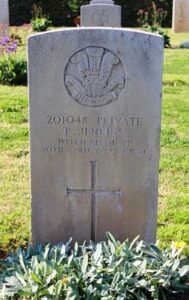
David James Lewis, Private, 5139, Welsh Regiment. David was born in Aberdare in 1893, the son of Thomas Lewis and Minnie Lewis (nee Davies). The family was from Narberth, but had resided for several years at Aberdare, before moving to 17, Waterloo Terrace, Pembroke Dock. David worked as a Porter for the Great Western Railways at Whitland prior to becoming a signalman at Henllan Station. He enlisted at Carmarthen into the 1/4th Battalion, Welsh Regiment soon after the outbreak of war. The battalion was the local Territorial unit and mobilised for war at Carmarthen in August 1914, as part of South Wales Brigade, Welsh Division and moved to Tunbridge Wells until the end of the month, before moving to Scotland to man the Forth and Tay Defences. The remainder of the Welsh Division then moved to Bedford, where it became numbered as the 53rd (Welsh) Division, and on 17 April 1915 the 4th Welsh moved to Bedford, joining 158 Brigade, of the 53rd (Welsh) Division. On 19 July 1915 the entire Division sailed from Devonport for Imbros and on 9 August 1915 landed at C Beach, south of Lala Baba, in Suvla Bay. The infantry moved off the beaches across the Salt Lake, under shellfire, into the scrub covered Chocolate Hill, but due to a lack of maps and no knowledge of the terrain, many of the units became disorientated, and the situation became chaotic. David had survived the chaotic first few days at Gallipoli, but was killed in action near Scimitar Hill on 23 August 1915. The 22-year-old is buried in Hill 10 Cemetery, Gallipoli.
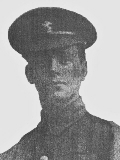
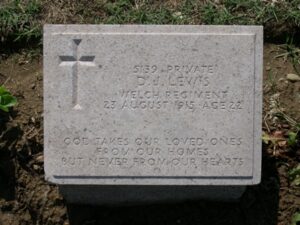
David Salmon, Private, 31204, Royal Welsh Fusiliers. David was born in 1895, the son of John Salmon and Sarah Salmon (nee James), of Lowlands, Narberth. Their mother, Sarah, was from St. Clears, and the family spent much of their time there. David worked as a farm labourer prior to enlisting at Carmarthen together with his brother Evan on 11 May 1915 into the Royal Field Artillery, and the brothers were given consecutive service numbers 98763 and 98764. Both brothers then transferred to the infantry on 4 June 1915 and on 18 December 1915 were posted to France, joining the 1st Battalion, Royal Welsh Fusiliers, which was attached to 22 Brigade, 7th Division. The battalion was billeted at Montagne when the brothers arrived, carrying out drill practise. Whilst resting and refitting after service during the Battle of Loos. The battalion remained here over the coming weeks, resting, refitting and carrying out specialist training, before the 7th Division took up positions on the Somme, facing Fricourt. The 1st RWF finally left Montagne on 30 January 1916 when it began marching towards the divisions new positions, and on 2 February took over trenches east of Méaulte. Over the coming weeks the infantry battalions of the division rotated between duty in the front line, whilst the Allies began to prepare for a great offensive on the Somme. At noon on 6 February 1916 the 1st RWF moved into support at The Citadel, near Fricourt, taking over dugouts there. Soon afterwards the Germans launched a heavy artillery bombardment upon their positions, killing two men and wounded five others. Sadly, both David and Evan were badly wounded during the barrage. David died of wounds that same day, aged 21. He is buried in Point 110 New Military Cemetery, Fricourt. His brother Evan died of his wounds on the following day.
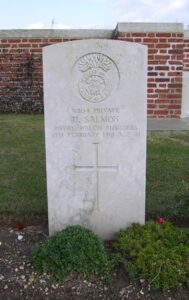
Evan Salmon, Private, 31203, Royal Welsh Fusiliers. Evan was born in 1892, the son of John Salmon and Sarah Salmon (nee James), of Lowlands, Narberth. Their mother, Sarah, was from St. Clears, and the family spent much of their time there. David worked as a farm labourer prior to enlisting at Carmarthen together with his brother Evan on 11 May 1915 into the Royal Field Artillery, and the brothers were given consecutive service numbers 98763 and 98764. Both brothers then transferred to the infantry on 4 June 1915 and on 18 December 1915 were posted to France, joining the 1st Battalion, Royal Welsh Fusiliers, which was attached to 22 Brigade, 7th Division. The battalion was billeted at Montagne when the brothers arrived, carrying out drill practise. Whilst resting and refitting after service during the Battle of Loos. The battalion remained here over the coming weeks, resting, refitting and carrying out specialist training, before the 7th Division took up positions on the Somme, facing Fricourt. The 1st RWF finally left Montagne on 30 January 1916 when it began marching towards the divisions new positions, and on 2 February took over trenches east of Méaulte. Over the coming weeks the infantry battalions of the division rotated between duty in the front line, whilst the Allies began to prepare for a great offensive on the Somme. At noon on 6 February 1916 the 1st RWF moved into support at The Citadel, near Fricourt, taking over dugouts there. Soon afterwards the Germans launched a heavy artillery bombardment upon their positions, killing two men and wounded five others. Sadly, both David and Evan were badly wounded during the barrage. David died of his wounds that same day, whilst Evan was evacuated to the Casualty Clearing Station at nearby Corbie, where he died of his wounds on the following day, on 7 February 1916, aged 23. He is buried in Corbie Communal Cemetery Extension.
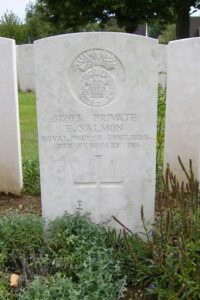
World War Two, 1939-1945
Gordon Wreford Griffiths, Leading Aircraftman, 1315678, Royal Air Force Volunteer Reserve. Gordon was born in 1921 the son of Alfred Griffiths and Winifred Ann Griffiths (nee Wreford). The family, from Pembrokeshire, had lived at Whitland for several years prior to the war, due to Alfred’s work as a wagon examiner for the Great Western Railway. Gordon enlisted into the Royal Air Force Volunteer Reserve and was posted to No 3 Service Flight Training School at South Cerney, in Gloucestershire for pilot training. On 26 October 1941, Gordon was carrying out a routine training flight, piloting an Airspeed Oxford I, Serial R6072, when it collided with Oxford N6267 of the same unit and crashed to the ground. Gordon was just 20 years old when he was killed that day. His body was recovered from the wreckage, and he was buried in Llanwnda Cemetery, Goodwick. He is also commemorated at the Memorial Hall, Whitland.
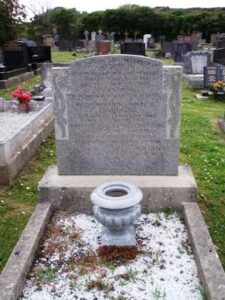
John Wynford Marsh Jones, Flight Sergeant, 1062633, Royal Air Force Volunteer Reserve. John was born on 2 January 1906, the son of Esther Jones, of 11 Park Street Whitland. He married Mary Auld Russell Young, the daughter of Robert Young, of the Gas Works, Whitland at Dursley on 10 February 1932. John enlisted into the Royal Air Force Volunteer Reserve and trained as a pilot, gaining his flying certificate at Lincolnshire Aero Club on 28 August 1939. He was then posted to 103 Squadron, Royal Air Force, which had been reformed in 1936 due to the growing German threat. The squadron was based in France at the outbreak of war, as part of the Advanced Air Strike Force, equipped with the obsolete Fairey Battle, but was withdrawn in June 1940 when the situation in France became critical. After spells at RAF Abingdon and Newton, the squadron took up permanent residence at R.A.F. Elsham Wolds in July 1941, as part of 1 Group, Bomber Command. By now it had been re-equipped with the Vickers Wellington, and was taking part in the 1,000 bomber raids on Nazi Germany. In July 1942 the squadron was re-equipped with the Handley Page Halifax, but they proved to be not up to the job, and after heavy losses the squadron converted to Avro Lancasters three months later. The squadron now took part on bombing missions over the industrial Ruhr Valley. On the night of 22 June 1943 John took off from RAF Elsham Wolds aboard an Avro Lancaster I, Serial ED773, as part of a 557 aircraft raid on Mulheim. The town was almost completely destroyed, but John’s Lancaster was shot down and crashed near the church of Téteghem, Nord, Hauts-de-France on the return journey the following morning, 23 June 1943, killing all her crew of eight men. The remains of John’s seven fellow crewmen were recovered from the wreckage and buried in Dunkirk Tow Cemetery, but the 37-year-old John has no known grave so is commemorated on the Runnymede Memorial, Surrey. John is commemorated on both Memorials at Whitland and is also commemorated on the Scunthorpe War Memorial.